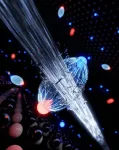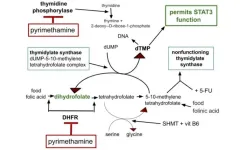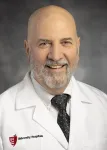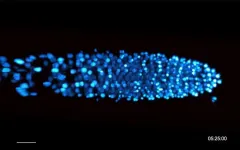(Press-News.org) Semiconductors are ubiquitous in modern technology, working to either enable or prevent the flow of electricity. In order to understand the potential of two-dimensional semiconductors for future computer and photovoltaic technologies, researchers from the Universities of Göttingen, Marburg and Cambridge investigated the bond that builds between the electrons and holes contained in these materials. By using a special method to break up the bond between electrons and holes, they were able to gain a microscopic insight into charge transfer processes across a semiconductor interface. The results were published in Science Advances.
When light shines on a semiconductor, its energy is absorbed. As a result, negatively charged electrons and positively charged holes combine in the semiconductor to form pairs, known as excitons. In the most modern two-dimensional semiconductors, these excitons have an extraordinarily high binding energy. In their study, the researchers set themselves the challenge of investigating the hole of the exciton. As physicist and first author Jan Philipp Bange from the University of Göttingen explains: "In our laboratory, we use photoemission spectroscopy to investigate how the absorption of light in quantum materials leads to charge transfer processes. So far, we have concentrated on the electrons that are part of the electron-hole pair, which we can measure using an electron analyser. Up to now, we didn’t have any way to directly access the holes themselves. So, we were interested in the question of how we could characterise not just the electron of the exciton but also its hole."
To answer this question, the researchers, led by Dr Marcel Reutzel and Professor Stefan Mathias at Göttingen University’s Faculty of Physics, used a special microscope for photoelectrons in combination with a high-intensity laser. In the process, the breaking up of an exciton leads to a loss of energy in the electron measured in the experiment. Reutzel explains: "This energy loss is characteristic for different excitons, depending on the environment in which the electron and the hole interact with each other." In the current study, the researchers used a structure consisting of two different atomically thin semiconductors to show that the hole of the exciton transfers from one semiconductor layer to the other, similar to a solar cell. Professor Ermin Malic's team at the University of Marburg was able to explain this charge transfer process with a model to describe what happens at a microscopic level.
Mathias summarises: "In the future, we want to use the spectroscopic signature of the interaction between electrons and holes to study novel phases in quantum materials at ultrashort time and length scales. Such studies can be the basis for the development of new technologies and we hope to contribute to this in the future."
This research benefited from the German Research Foundation (DFG) funding for the Collaborative Research Centres "Atomic scale control of energy conversion" and "Mathematics of Experiment" in Göttingen and "Structure and Dynamics of Internal Interfaces" in Marburg.
Original publication: Bange et al., Probing electron-hole Coulomb correlations in the exciton landscape of a twisted semiconductor heterostructure, Science Advances (2024). DOI: 10.1126/sciadv.adi1323
Contact:
Professor Stefan Mathias
University of Göttingen
Faculty of Physics
Friedrich Hund Platz 1, 37077 Göttingen, Germany
Tel: +49 (0)551 39-27601
Email: smathias@uni-goettingen.de
www.mathiaslab.uni-goettingen.de
Dr Marcel Reutzel
University of Göttingen
Faculty of Physics
Friedrich Hund Platz 1, 37077 Göttingen, Germany
Email: marcel.reutzel@phys.uni-goettingen.de
END
How electron spectroscopy measures exciton “holes”
Researchers gain insights into charge transfer at atomically thin interfaces between semiconductors
2024-02-09
ELSE PRESS RELEASES FROM THIS DATE:
IPIAD: an augmentation to standard treatment of PDAC using five repurposed drugs
2024-02-09
“This paper presents the rationale for adding five already approved and marketed generic drugs from general medical practice to the current standard current first line chemotherapy for pancreatic ductal adenocarcinoma (PDAC).”
BUFFALO, NY- February 9, 2024 – A new research perspective was published in Oncoscience (Volume 11) on February 7, 2024, entitled, “IPIAD- an augmentation regimen added to standard treatment of pancreatic ductal adenocarcinoma using already-marketed repurposed drugs irbesartan, pyrimethamine, itraconazole, azithromycin, and dapsone.”
In this new paper, researcher Richard E. Kast from IIAIGC Study Center presents the ...
UT Health San Antonio School of Dentistry opens dental clinic for special-needs children, adults
2024-02-09
SAN ANTONIO, Feb. 9, 2024 – The UT Health San Antonio School of Dentistry has opened a special-care dental clinic, the first of its kind in an academic setting in South Texas that will serve people of all ages with intellectual, developmental, cognitive or physical disabilities.
With spacious, specially designed treatment rooms featuring adjustable sound and lighting and even a “Zen Den” multi-sensory room to help reduce anxiety, the Phil and Karen Hunke Special Care Clinic occupies approximately ...
This ultrasound sticker senses changing stiffness of deep internal organs
2024-02-09
MIT engineers have developed a small ultrasound sticker that can monitor the stiffness of organs deep inside the body. The sticker, about the size of a postage stamp, can be worn on the skin and is designed to pick up on signs of disease, such as liver and kidney failure and the progression of solid tumors.
In an open-access study that will appear in Science Advances, the team reports that the sensor can send sound waves through the skin and into the body, where the waves reflect off internal organs and back out to the sticker. The pattern of the reflected waves can be read as ...
Yale joins the ‘Snowball’ fight over global deep freeze periods
2024-02-09
New Haven, Conn. — A Yale-led research team has picked a side in the “Snowball Earth” debate over the possible cause of planet-wide deep freeze events that occurred in the distant past.
According to a new study, these so-called “Snowball” Earth periods, in which the planet’s surface was covered in ice for thousands or even millions of years, could have been triggered abruptly by large asteroids that slammed into the Earth.
The findings, detailed in the journal Science Advances, may answer a question ...
Sensors made from ‘frozen smoke’ can detect toxic formaldehyde in homes and offices
2024-02-09
Researchers have developed a sensor made from ‘frozen smoke’ that uses artificial intelligence techniques to detect formaldehyde in real time at concentrations as low as eight parts per billion, far beyond the sensitivity of most indoor air quality sensors.
The researchers, from the University of Cambridge, developed sensors made from highly porous materials known as aerogels. By precisely engineering the shape of the holes in the aerogels, the sensors were able to detect the fingerprint of formaldehyde, a common indoor air pollutant, at room temperature.
The proof-of-concept sensors, which require minimal power, could be adapted to detect ...
University Hospitals now offering FDA-approved medication for treatment of Alzheimer’s disease
2024-02-09
CLEVELAND—University Hospitals (UH) Brain Health & Memory Center is now treating patients with LEQEMBI® (lecanemab), a Food and Drug Administration-approved medication for the treatment of Alzheimer’s disease.
“Those with Alzheimer’s disease often have an abnormal buildup of plaques in their brain that contain a protein called beta-amyloid,” said Charles J. Duffy, MD, PhD, neurologist and Director of the Brain Health & Memory Center within the UH Neurological Institute. “Lecanemab ...
Unlocking quantum precision: Expanded superconducting strips for enhanced photon-counting accuracy
2024-02-09
Using single photons as qubits has become a prominent strategy in quantum information technology. Accurately determining the number of photons is crucial in various quantum systems, including quantum computation, quantum communication, and quantum metrology. Photon-number-resolving detectors (PNRDs) play a vital role in achieving this accuracy and have two main performance indicators: resolving fidelity, which measures the probability of accurately recording the number of incident photons, and dynamic range, which describes the maximum resolvable photon number.
Superconducting nanostrip single-photon detectors (SNSPDs) are considered the leading ...
From growing roots, clues to how stem cells decide their fate
2024-02-09
DURHAM, N.C. -- It might look like a comet or a shooting star, but this time-lapse video is actually a tiny plant root, not much thicker than a human hair, magnified hundreds of times as it grows under the microscope.
Researchers at Duke University have been making such movies by peering at stem cells near the root’s tip and taking snapshots as they divide and multiply over time, using a technique called light sheet microscopy.
The work offers more than a front row seat to the drama of growing roots. By watching how the cells divide in response to certain chemical signals, the team is finding new clues to how stem cells choose one ...
UK's Nursing’s Stanifer chosen as scholar in Environmental Health Research Institute for Nurse and Clinician Scientists
2024-02-09
LEXINGTON, Ky. (Feb. 8, 2024) — A researcher in the University of Kentucky College of Nursing has been selected as a scholar for the Environmental Health Research Institute for Nurse and Clinician Scientists (EHRI-NCS).
EHRI-NCS is a year-long flipped classroom, train-the-trainer and mentorship program aimed at developing a new era of environmental health nursing science. It’s led by Castner Incorporated, a health research company, in partnership with Emory University, Washington State University and University of Alabama in Huntsville.
Stacy Stanifer, Ph.D., an advanced practice registered nurse and an assistant professor of nursing, was selected to participate. ...
Protein accumulation on fat droplets implicated in late-onset Alzheimer’s disease
2024-02-09
CHAPEL HILL, N.C. – UNC School of Medicine researcher Sarah Cohen, PhD, and Ian Windham, a former PhD student from the Cohen lab, have made a new discovery about apolipoprotein E (APOE) – the biggest genetic risk factor for late-onset Alzheimer’s disease.
Older people who inherited a genetic variant called APOE4 from their parents have a two- or three-times greater risk of developing the late-onset neurodegenerative disease. If researchers can better understand how APOE4 is affecting brain cells, it may help them design effective therapeutics and target the mechanisms causing the enhanced disease risk.
Cohen and Windham performed an exceptionally ...
LAST 30 PRESS RELEASES:
New science reporting guide published for journalists in Bulgaria
New international study reveals major survival gaps among children with cancer
New science reporting guide published for journalists in Turkey
Scientists develop a smarter mRNA therapy that knows which cells to target
Neuroanatomy-informed brain–machine hybrid intelligence for robust acoustic target detection
Eight SwRI hydrogen projects funded by ENERGYWERX
The Lundquist Institute and its start-up company Vitalex Biosciences Announces Strategic Advancement of Second-Generation fungal Vaccine VXV-01 through Phase 1 Trials under $40 Million Competitive Con
Fine particles in pollution are associated with early signs of autoimmune disease
Review article | Towards a Global Ground-Based Earth Observatory (GGBEO): Leveraging existing systems and networks
Penn and UMich create world’s smallest programmable, autonomous robots
Cleveland researchers launch first major study to address ‘hidden performance killer’ in athletes
To connect across politics, try saying what you oppose
Modulating key interaction prevents virus from entering cells
Project explores barriers to NHS career progression facing international medical graduates
Jeonbuk National University researchers explore the impact of different seasonings on the flavor perception of Doenjang soup
Two Keck Medicine of USC Hospitals named Leapfrog Top Teaching Hospitals
World-first discovery uncovers how glioblastoma tumours dodge chemotherapy, potentially opening the door to new treatments
A fatal mix-up: How certain gut bacteria drive multiple sclerosis
New AI tool identifies not just genetic mutations, but the diseases they may cause
Deep-learning model predicts how fruit flies form, cell by cell
Combination pills for high blood pressure may simplify treatment, improve long-term health
Immune system keeps mucosal fungi in check
Neurons within the brain use simple rules to localize genetic messages
Electrodes created using light
Second-hand gift-giving is a well-deliberated decision
How human interaction drove evolution to make bears less aggressive
National Poll: Few parents offer teens guidance on healthy eating during holiday season
Cannabis derivatives could provide new ovarian cancer treatments
Raising strong yeast as a petroleum substitute
Clues to the origin of hot Jupiters hidden in their orbits
[Press-News.org] How electron spectroscopy measures exciton “holes”Researchers gain insights into charge transfer at atomically thin interfaces between semiconductors





